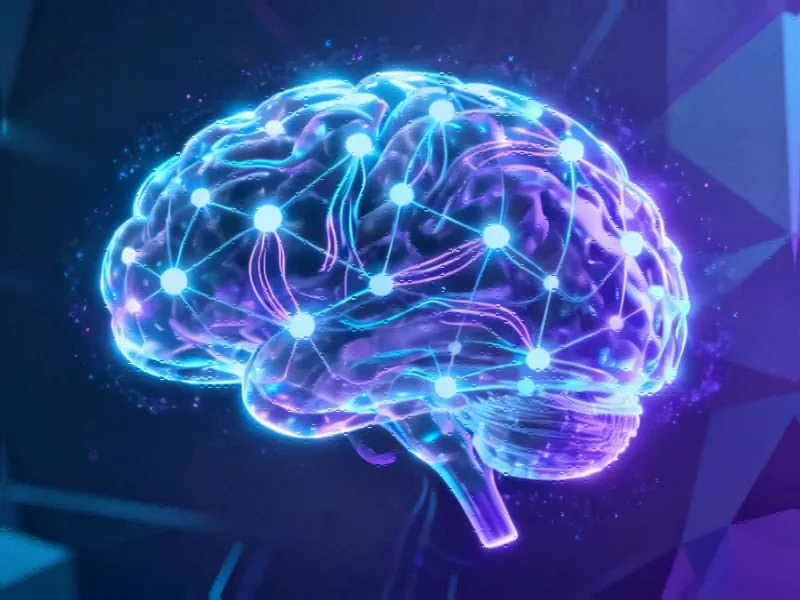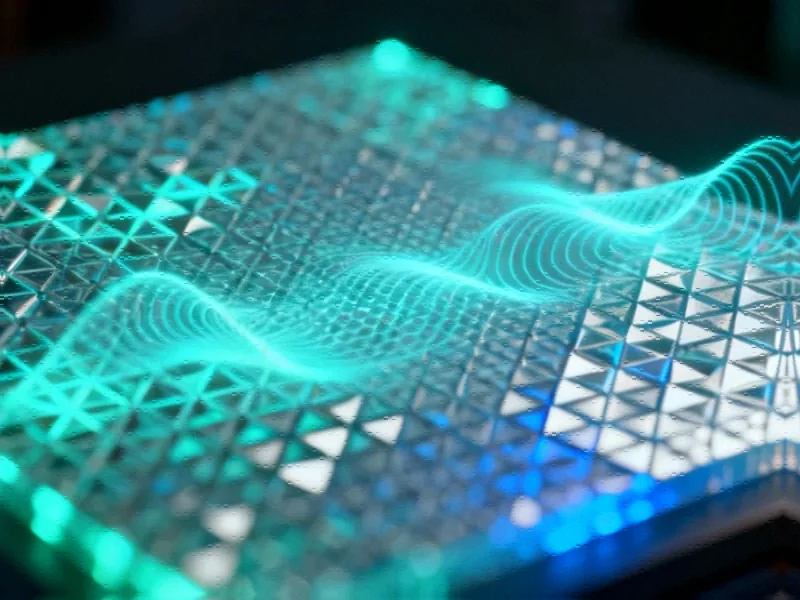Breakthrough in Materials Science AI
Researchers have unveiled CrystalFlow, an advanced generative model for crystalline materials that addresses critical limitations in crystal structure prediction, according to reports published in Nature Communications. The model reportedly overcomes computational inefficiency problems that have plagued previous approaches while effectively capturing the intrinsic symmetries of crystals, representing a significant advancement in the rapidly evolving field of materials informatics.
Technical Innovation and Architecture
Sources indicate that CrystalFlow employs Continuous Normalizing Flows within the Conditional Flow Matching framework, transforming simple prior density into complex data distributions that capture structural and compositional intricacies of crystalline materials. Unlike previous methods that struggled with symmetry preservation, CrystalFlow explicitly incorporates the fundamental periodic-E(3) symmetries of crystalline systems through recent advancements in graph-based equivariant message-passing networks.
The architecture reportedly models the conditional probability distribution over crystal structures using what analysts describe as an equivariant map approach, parameterizing time-dependent vector fields for the lattice, fractional atomic coordinates, and atomic types. This formulation collectively defines flow transformations that preserve the intrinsic symmetries of crystals, including permutation, rotation, and periodic translation invariance.
Superior Performance Metrics
According to the report, CrystalFlow demonstrates performance comparable to or exceeding state-of-the-art models across standard generation metrics. When evaluated on benchmark datasets MP-20 and MPTS-52, the model achieved the best performance among all four compared models on the more challenging MPTS-52 dataset. The evaluation methodology followed established practices in the crystal generative modeling community, calculating match rate and root mean squared error on test sets.
Perhaps most impressively, the report states that CrystalFlow is approximately an order of magnitude faster than diffusion-based models while maintaining comparable or superior generation quality. This substantial efficiency gain is primarily attributed to the significantly fewer integration steps required by flow-based models, which not only accelerates sample generation but also reduces computational costs for large-scale applications.
Pressure-Conditioned Generation Capabilities
The model’s versatility extends to conditional generation, with sources indicating it can generate structures optimized for specific external pressures or material properties when trained with appropriately labeled data. In tests using the extensive MP-CALYPSO-60 dataset comprising 657,377 crystal structures, CrystalFlow demonstrated superior ability to learn and incorporate pressure effects within the generative modeling process.
Analysis of the relationship between DFT-computed lattice stresses and target pressures revealed that structures generated by CrystalFlow exhibited significantly improved alignment with target pressures compared to those generated by competing models. This capability is particularly important for simulating realistic conditions that materials may encounter in practical structure prediction applications, according to industry experts monitoring industry developments.
Computational Efficiency and Practical Applications
The report suggests that CrystalFlow-generated structures generally achieve higher convergence rates during quantum-mechanical geometry optimization and require fewer ionic steps compared to alternative approaches. At an integration step of S = 5000, CrystalFlow required 39.82 average ionic steps, representing a 13.3% reduction in computational cost compared to the 45.91 steps needed for Cond-CDVAE.
Further analysis revealed that approximately 55.2% of structures generated by CrystalFlow after local optimization were new—not present in the training set. This level of structural newness rate demonstrates comparable performance to state-of-the-art generative models while maintaining computational efficiency that could accelerate materials discovery across multiple sectors, including those affected by market trends in automotive and electronics.
Technical Implementation Details
The model represents a unit cell of a crystalline structure containing N atoms using established conventions in the crystal generative modeling community. To ensure rotational invariance in the lattice representation, an alternative parameterization is adopted using a rotation-invariant vector derived via polar decomposition, effectively decoupling rotational and structural information.
During inference, random initial structures are sampled from simple prior distributions and evolved toward realistic crystal configurations through learned conditional probability paths. The model employs numerical ordinary differential equation solvers to generate crystal structures, with adjustable integration steps to balance computational efficiency and sample quality. This approach to modeling the lattice structure represents a significant advancement over previous methods that struggled with symmetry preservation.
Broader Implications and Future Directions
The development of CrystalFlow comes amid significant recent technology advancements across multiple AI domains. Its ability to efficiently generate stable and metastable crystal configurations enables accelerated exploration of new materials and their properties, potentially transforming materials discovery pipelines in pharmaceuticals, energy storage, and semiconductor development.
Industry observers note that such computational advancements align with broader related innovations in materials science and artificial intelligence. However, experts caution that maintaining robust computational infrastructure remains crucial, as highlighted by industry developments in cloud computing reliability. The successful implementation of CrystalFlow demonstrates how specialized AI models can drive scientific discovery while optimizing computational resources.
This article aggregates information from publicly available sources. All trademarks and copyrights belong to their respective owners.
Note: Featured image is for illustrative purposes only and does not represent any specific product, service, or entity mentioned in this article.



